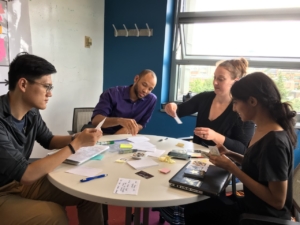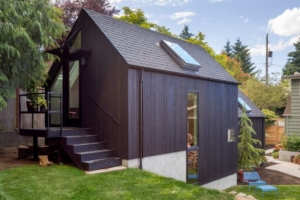August 16, 2019

The City of Seattle is collaborating with an interdisciplinary team in the eScience Institute’s Data Science for Social Good (DSSG) program on a project to encourage the development of affordable accessory dwelling units (ADUs). The team is prototyping an informational tool for homeowners and researchers as part of broader citywide efforts to increase affordable housing options in high opportunity neighborhoods. The prototyping effort is mentioned in an executive order signed by Seattle Mayor Jenny Durkan following the passage of legislation intended to foster ADU development in Seattle.
The DSSG prototype assists homeowners in determining the feasibility of developing an ADU. It addresses design, permitting, construction and financing issues, with a calculator to estimate construction costs, property loans, monthly payments and predicted changes in assessed property value. The interface shows a map of Seattle with data aggregated by neighborhood, such as the number of properties eligible for a detached ADU, or backyard cottage, combined with population and income statistics. Once a user enters their address, a customized map shows existing ADUs around the address, which neighbors can use to see who has one in their area. Finally, the tool provides resources on becoming a landlord.
ADUs operate like rental apartments, although they typically rent at below-market rates, often to a homeowner’s friends or family members. Permitting of ADUs began in 1994 for units “attached” to the main house (AADUs) in a basement, upper floor, or lower floor, and in 2010 for “detached” units (DADUs). To date, about 2,400 ADUs have been permitted in Seattle. AADUs are allowed on all single-family properties, but a few key factors can disqualify homeowners from eligibility to construct a DADU: location within a certain distance of the shoreline, insufficient lot area, and inadequate yard space for construction. The city does not have an estimate of informal ADUs.
In July, the City Council approved legislative changes to encourage the development of more ADUs, including allow two ADUs on a single lot, reducing the minimum lot size, allowing larger DADUs, and removing owner-occupancy and off-street parking requirements. The DSSG team attended the final vote. Mayor Durkan mentioned the project in an executive order issued on July 9, 2019, that describes the city’s actions to encourage the creation of more affordable ADUs. Durkan noted that the prototype tool created at the DSSG could be adapted into a service for homeowners to determine the feasibility of building an ADU on their property.
The project involves direct interactions with stakeholders. In addition to attending a City Council meeting, the team made a presentation at the Seattle Planning Commission and went on an ADU tour where homeowners shared concerns and considerations that the team incorporated into the tool, such as adding data about ADUs on a corner lot, in an alley, or in a basement with daylight. “Getting to talk to people actually involved in the activism and seeing the swell of interest from people in different backgrounds, and the position of the city to actually implement policy, that was very informative for me to realize how big the scope of this project really is and what the impact potentially could be with the right support behind it,” said fellow Adrian Mikelangelo Tullock, a UW masters student in Interdisciplinary Data Science.
Fellow Anagha Uppal, a Ph.D. geography student at the University of California, Santa Barbara, described how building a user-friendly tool grew in importance during the course of the program. “Initially we focused on the modeling piece and understanding the factors for building an ADU. But over time we realized that component, although important, was less relevant than producing the outward-facing tool,” she said. In addition to serving homeowners, the tool has research, education, and analytical applications. For example, it could reveal neighborhoods with high rates of eligibility and limited average incomes, indicating an opportunity for promoting ADU creation through financial assistance programs.
Fellow Emily A. Finchum-Mason, a Ph.D. candidate in the UW Evans School of Public Policy & Governance said she’s curious to see how this tool influences public behavior. “I’m interested in using this as a platform to better understand the public information campaign as a means of inducing this behavior, and how this helps us understand the overall landscape of affordability housing in Seattle what our key levers are for making the needle move,” she said.

The project utilizes open-source data from the King County Assessor and the City of Seattle’s GIS data, along with financial data from Zillow, which they cross-checked with sales and assessment data. Technical tools used include Python, SQL, and GIS. Joseph Hellerstein, senior data science fellow at the eScience Institute and an affiliate professor of computer science and engineering at the UW, is the project’s data science lead. In trying to determine the overall uses of ADUs, such as short versus long-term housing, the team looked at data from Portland and Vancouver. They examined local Airbnb listings, where they found listings both for ADUs and for homes in which owners live in their ADU and rent out their main house. The team also conducted an econometric analysis based on past home sales.
ADUs provide a unique opportunity to increase affordable housing by utilizing land that is already owned. However, affordability is not an inherent part of ADUs, so additional incentives are necessary. Project lead Rick Mohler, an associate professor in the UW Department of Architecture and a member of the Seattle Planning Commission and Seattle’s ADU working group, said the tool is intended to link to City programs promoting the development of affordable ADUs, which are currently in the discussion or planning stages. The program could offer financial and technical assistance to a homeowner who agrees to rent their ADU to a low-income household.
“The dream scheme, and Seattle is one of a number of cities exploring this, is the idea that you do things at once: you financially bolster a low-income homeowner by giving them passive income, and then you simultaneously provide a rent-restricted housing unit. It’s a fantastic and compelling story on so many levels, but at some point, people who are charged with using limited resources for affordable housing have to look at it through that lens,” Rick said.
Project lead Nicolas Welch, a senior planner at the Seattle Office of Planning and Community Development, said the tool could serve as a model for other cities. “We won’t be able to build the tool for other cities, but we may be able to exchange the lessons learned and how to do it. It could serve as a model,” he said. The team’s Github page has open-source code, making the tool adaptable by other jurisdictions, although adjustments would be needed to account for differences in local data, regulations, land use and building codes, and market factors.
One of the final steps is to determine which parcel-specific data points are appropriate to include in the tool. Fellow Yuanhao Niu, a Ph.D. economics student at the University of Notre Dame, said the project has taught him about the ethical complexities involved in working with public data. “Though all of the data we use is publicly available from the City, we are making it very easy for people to access at a very granular level. There are potential ethical concerns. We are in the process of deciding how much information to put in the platform to gain trust and not discourage people and make them feel like too much of their privacy is exposed,” he said.
Final presentations by all four of this year’s DSSG project teams will take place from 3 to 5 p.m. Wednesday, Aug. 21. The event is open to the public.

